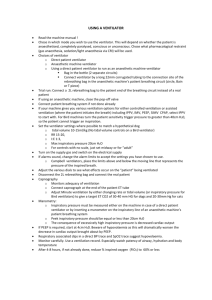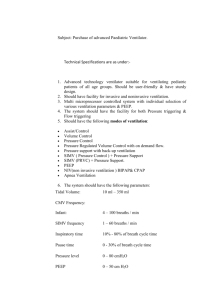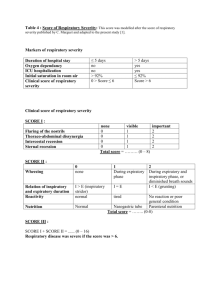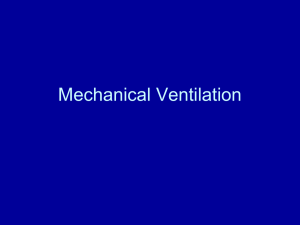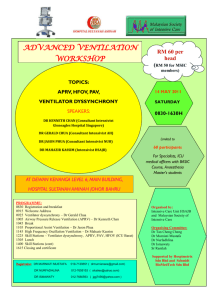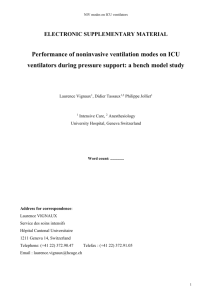August Up 2 Date Pressure-Regulated Volume Control Ventilation
advertisement
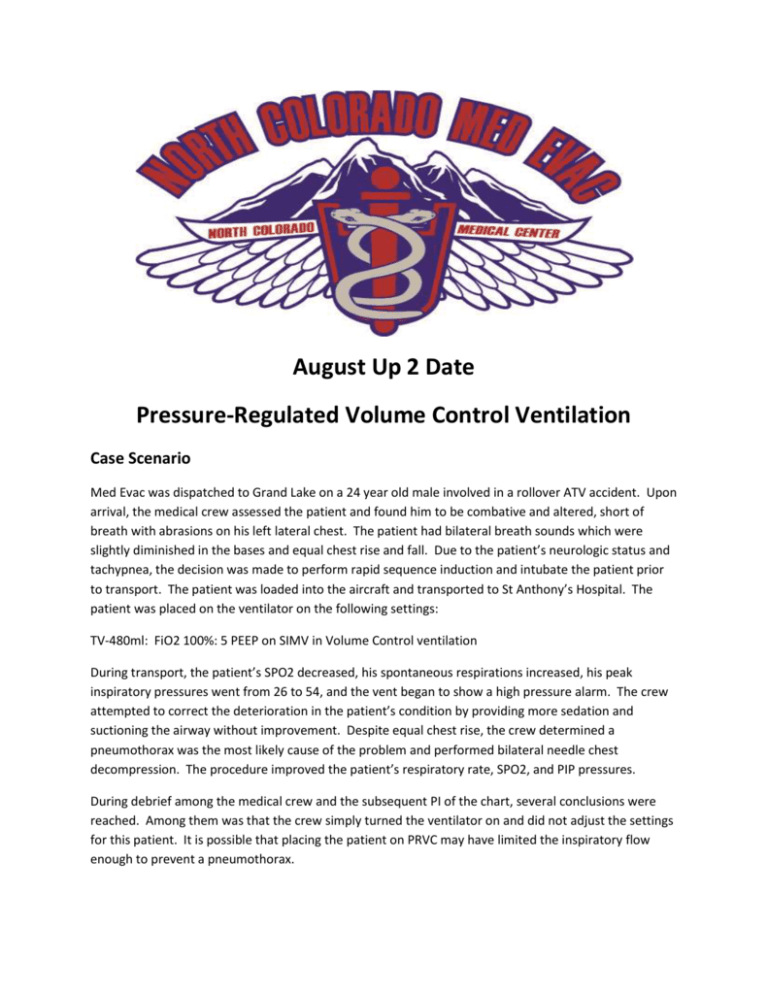
August Up 2 Date Pressure-Regulated Volume Control Ventilation Case Scenario Med Evac was dispatched to Grand Lake on a 24 year old male involved in a rollover ATV accident. Upon arrival, the medical crew assessed the patient and found him to be combative and altered, short of breath with abrasions on his left lateral chest. The patient had bilateral breath sounds which were slightly diminished in the bases and equal chest rise and fall. Due to the patient’s neurologic status and tachypnea, the decision was made to perform rapid sequence induction and intubate the patient prior to transport. The patient was loaded into the aircraft and transported to St Anthony’s Hospital. The patient was placed on the ventilator on the following settings: TV-480ml: FiO2 100%: 5 PEEP on SIMV in Volume Control ventilation During transport, the patient’s SPO2 decreased, his spontaneous respirations increased, his peak inspiratory pressures went from 26 to 54, and the vent began to show a high pressure alarm. The crew attempted to correct the deterioration in the patient’s condition by providing more sedation and suctioning the airway without improvement. Despite equal chest rise, the crew determined a pneumothorax was the most likely cause of the problem and performed bilateral needle chest decompression. The procedure improved the patient’s respiratory rate, SPO2, and PIP pressures. During debrief among the medical crew and the subsequent PI of the chart, several conclusions were reached. Among them was that the crew simply turned the ventilator on and did not adjust the settings for this patient. It is possible that placing the patient on PRVC may have limited the inspiratory flow enough to prevent a pneumothorax. Didactic Pressure regulated volume control is an IMV based mode. Pressure regulated volume control utilizes pressure-limited, volume-targeted, time-cycled breaths which can be either ventilator or patient initiated. The peak inspiratory pressure delivered by the ventilator is varied on a breath-to-breath basis based on changes in the patient’s airway resistance and respiratory compliance to achieve a target tidal volume which is set by the clinician. For example, if a target tidal volume of 500 mL is set but the ventilator delivers 600 mL, the next breath will be delivered with a lower inspiratory pressure to achieve a lower tidal volume. Though PRVC is regarded as a hybrid mode because of its tidal-volume (VC) settings and pressure-limiting (PC) settings fundamentally PRVC is a volume-control mode. The maximum allowed inspiratory pressure in PRVC is 5cm H20 below the upper pressure limit (2, 4). The pattern can be illustrated by the following waveform: During PRVC ventilations there is a maximum pressure difference between the ventilator and the lung at the beginning of the inspiratory cycle. The resulting flow is also maximal. With the increase in intrathoracic pressure this difference diminishes as does the resulting inspiratory flow, this is called decelerating inspiratory flow. By contrast, in pure volume control ventilation there is constant inspiratory flow and the resulting intrathoracic pressure is always increasing. PRVC is therefore capable of delivering the same volume at a lower peak inspiratory pressure (1). Conclusions During mechanical ventilation, the application of positive pressure with a PIP greater than 50-60cm H2O may result in barotrauma (3). One specific study did show that during mechanical ventilation for acute respiratory failure PIP was significantly lower on PRVC than VC (1). PRVC ventilation is ideal for pediatric, chest trauma, and acute respiratory failure patients. The patient’s individual disease process should always be considered when establishing ventilator settings; asthma and COPD patients, for example, would not be good candidates for PRVC type ventilation. References 1. Guldager, H. et al. “A Comparison of Volume Control and Pressure-Regulated Volume Control Ventilation in Acute Respiratory Failure.” Critical Care. 1997; 1(2): 75-77. 2. Gomersall, C. “Pressure-Regulated Volume Control.” http://www.aic.cuhk.edu 3. Slustsky, AS. “ACCP Consensus Conference: Mechanical Ventilation.” Chest. 1993; 104: 18331859. 4. ReVel Ventilator Operator’s Manual; P/N 12432-001.
